sensor JEEP RENEGADE 2015 1.G Owner's Manual
[x] Cancel search | Manufacturer: JEEP, Model Year: 2015, Model line: RENEGADE, Model: JEEP RENEGADE 2015 1.GPages: 678, PDF Size: 29.84 MB
Page 253 of 678

Lane Changing Of Other Vehicles
Vehicles that suddenly change lane, while standing in the
traffic lane of their car and inside the field of action of the
radar sensor may cause the intervention of the system.
Passing Of Vehicles In An Oncoming Intersection
The system could temporarily react to a vehicle that
crossed the range of the radar sensor, in an oncoming
intersection.
Lane Changing Of Other VehiclesPassing Of Vehicles In An Oncoming Intersection
6
SAFETY 251
Page 272 of 678
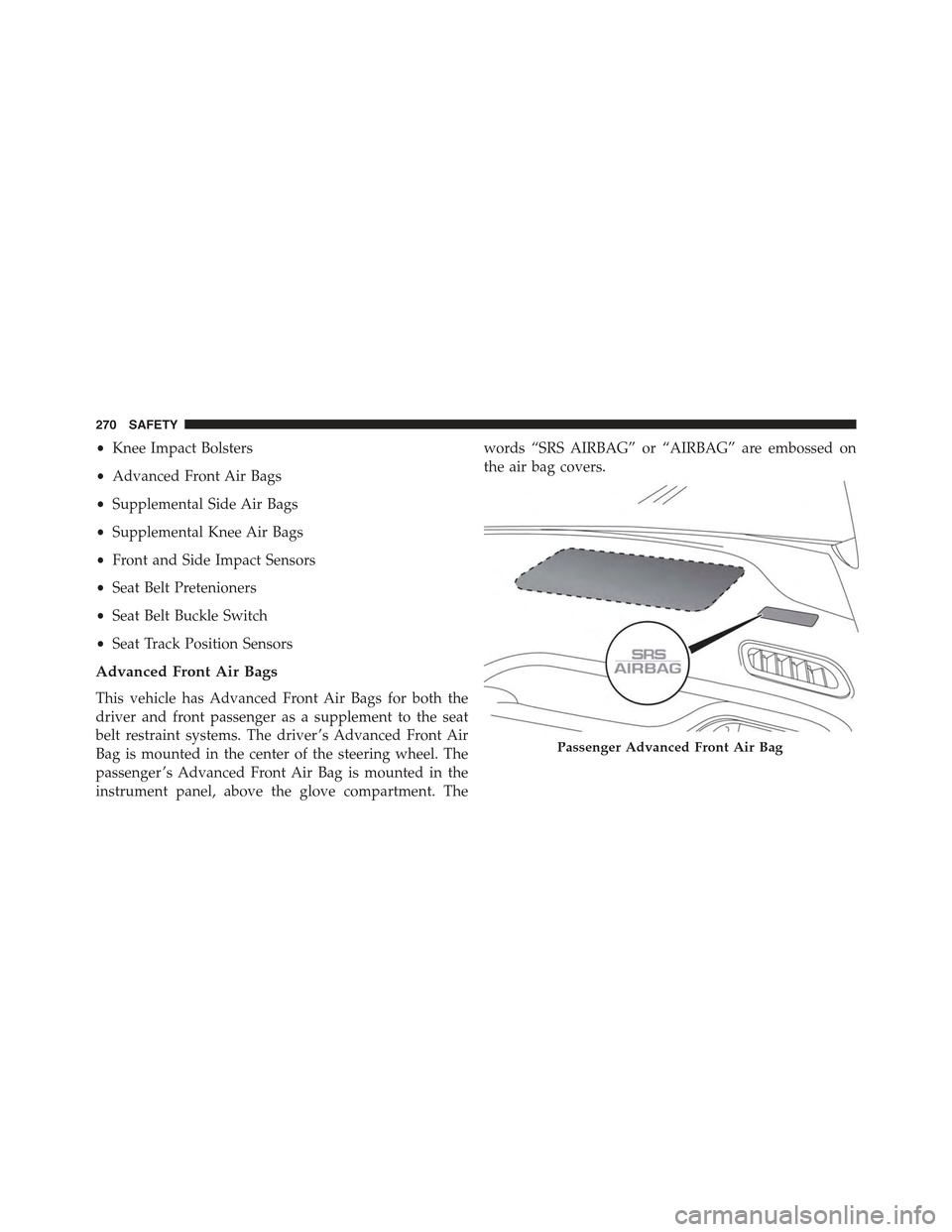
•Knee Impact Bolsters
•Advanced Front Air Bags
•Supplemental Side Air Bags
•Supplemental Knee Air Bags
•Front and Side Impact Sensors
•Seat Belt Pretenioners
•Seat Belt Buckle Switch
•Seat Track Position Sensors
Advanced Front Air Bags
This vehicle has Advanced Front Air Bags for both the
driver and front passenger as a supplement to the seat
belt restraint systems. The driver ’s Advanced Front Air
Bag is mounted in the center of the steering wheel. The
passenger ’s Advanced Front Air Bag is mounted in the
instrument panel, above the glove compartment. The
words “SRS AIRBAG” or “AIRBAG” are embossed on
the air bag covers.
Passenger Advanced Front Air Bag
270 SAFETY
Page 274 of 678
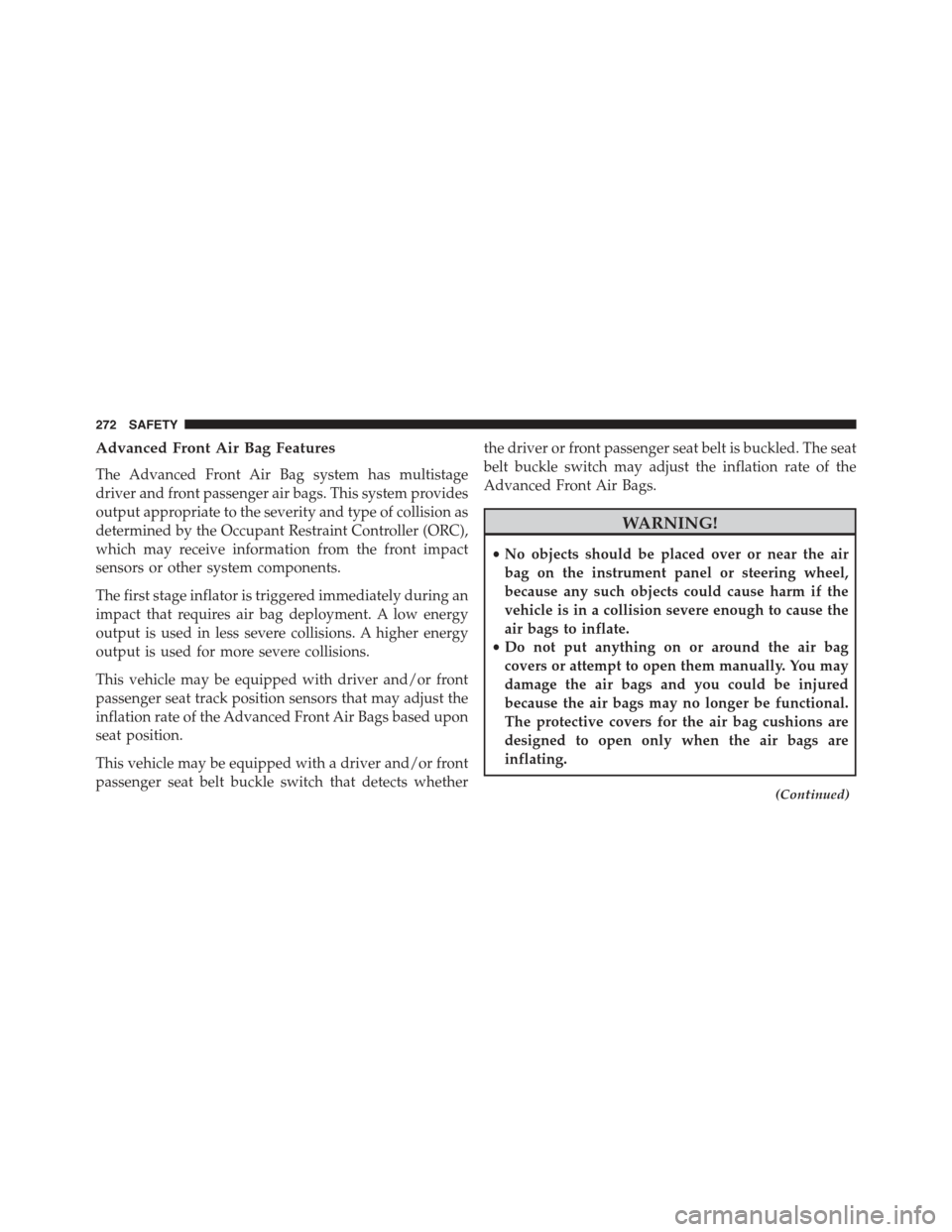
Advanced Front Air Bag Features
The Advanced Front Air Bag system has multistage
driver and front passenger air bags. This system provides
output appropriate to the severity and type of collision as
determined by the Occupant Restraint Controller (ORC),
which may receive information from the front impact
sensors or other system components.
The first stage inflator is triggered immediately during an
impact that requires air bag deployment. A low energy
output is used in less severe collisions. A higher energy
output is used for more severe collisions.
This vehicle may be equipped with driver and/or front
passenger seat track position sensors that may adjust the
inflation rate of the Advanced Front Air Bags based upon
seat position.
This vehicle may be equipped with a driver and/or front
passenger seat belt buckle switch that detects whether
the driver or front passenger seat belt is buckled. The seat
belt buckle switch may adjust the inflation rate of the
Advanced Front Air Bags.
WARNING!
•No objects should be placed over or near the air
bag on the instrument panel or steering wheel,
because any such objects could cause harm if the
vehicle is in a collision severe enough to cause the
air bags to inflate.
•Do not put anything on or around the air bag
covers or attempt to open them manually. You may
damage the air bags and you could be injured
because the air bags may no longer be functional.
The protective covers for the air bag cushions are
designed to open only when the air bags are
inflating.
(Continued)
272 SAFETY
Page 275 of 678
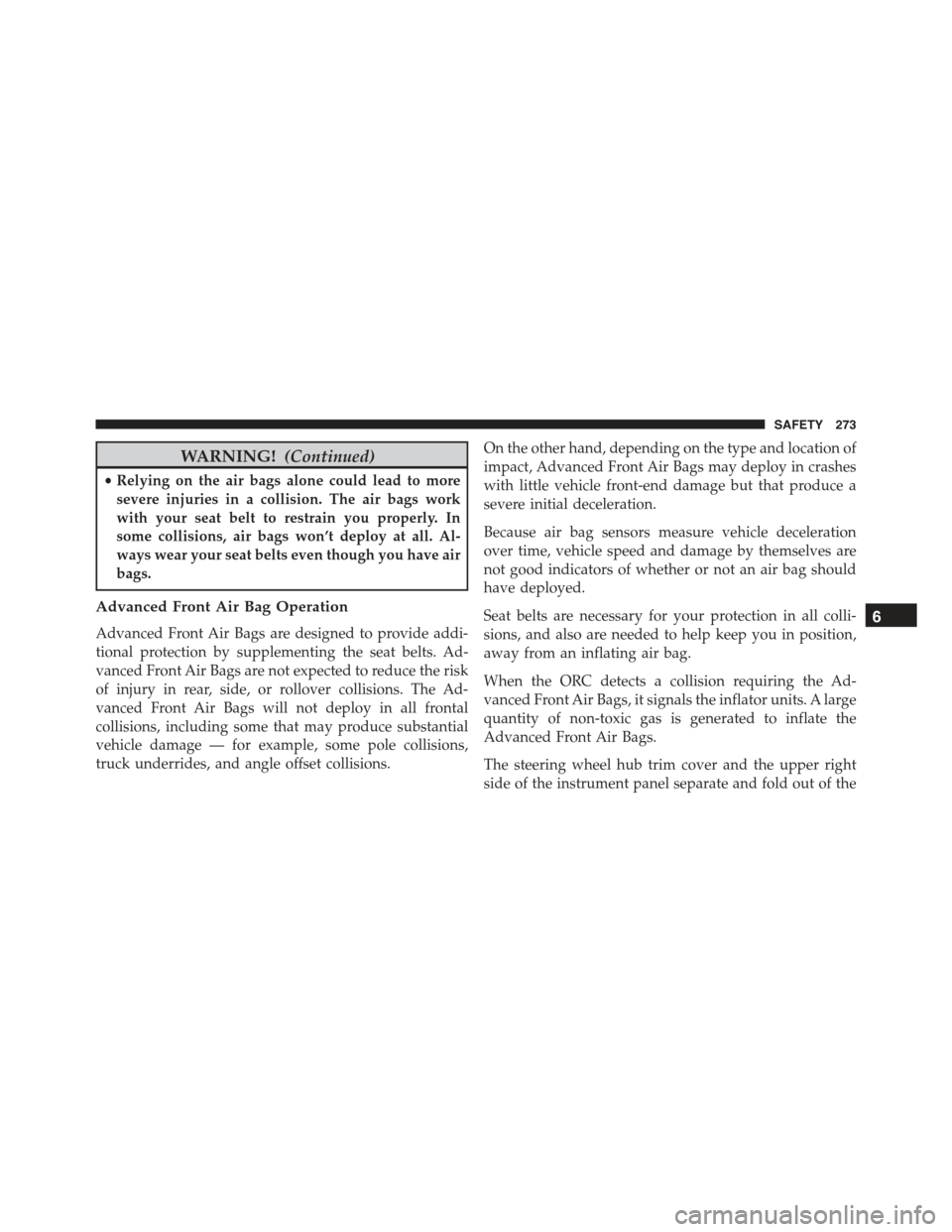
WARNING!(Continued)
•Relying on the air bags alone could lead to more
severe injuries in a collision. The air bags work
with your seat belt to restrain you properly. In
some collisions, air bags won’t deploy at all. Al-
ways wear your seat belts even though you have air
bags.
Advanced Front Air Bag Operation
Advanced Front Air Bags are designed to provide addi-
tional protection by supplementing the seat belts. Ad-
vanced Front Air Bags are not expected to reduce the risk
of injury in rear, side, or rollover collisions. The Ad-
vanced Front Air Bags will not deploy in all frontal
collisions, including some that may produce substantial
vehicle damage — for example, some pole collisions,
truck underrides, and angle offset collisions.
On the other hand, depending on the type and location of
impact, Advanced Front Air Bags may deploy in crashes
with little vehicle front-end damage but that produce a
severe initial deceleration.
Because air bag sensors measure vehicle deceleration
over time, vehicle speed and damage by themselves are
not good indicators of whether or not an air bag should
have deployed.
Seat belts are necessary for your protection in all colli-
sions, and also are needed to help keep you in position,
away from an inflating air bag.
When the ORC detects a collision requiring the Ad-
vanced Front Air Bags, it signals the inflator units. A large
quantity of non-toxic gas is generated to inflate the
Advanced Front Air Bags.
The steering wheel hub trim cover and the upper right
side of the instrument panel separate and fold out of the
6
SAFETY 273
Page 280 of 678
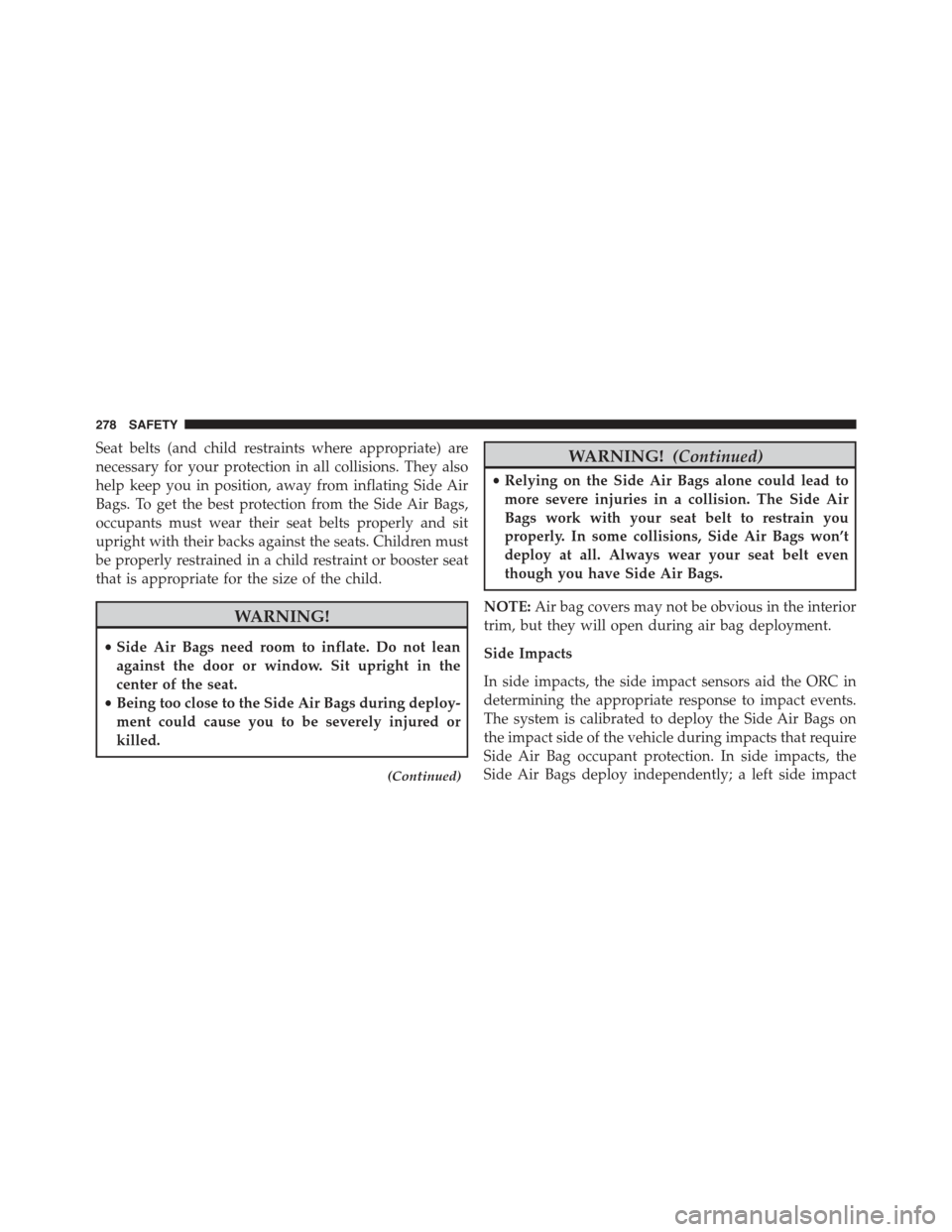
Seat belts (and child restraints where appropriate) are
necessary for your protection in all collisions. They also
help keep you in position, away from inflating Side Air
Bags. To get the best protection from the Side Air Bags,
occupants must wear their seat belts properly and sit
upright with their backs against the seats. Children must
be properly restrained in a child restraint or booster seat
that is appropriate for the size of the child.
WARNING!
•Side Air Bags need room to inflate. Do not lean
against the door or window. Sit upright in the
center of the seat.
•Being too close to the Side Air Bags during deploy-
ment could cause you to be severely injured or
killed.
(Continued)
WARNING!(Continued)
•Relying on the Side Air Bags alone could lead to
more severe injuries in a collision. The Side Air
Bags work with your seat belt to restrain you
properly. In some collisions, Side Air Bags won’t
deploy at all. Always wear your seat belt even
though you have Side Air Bags.
NOTE:Air bag covers may not be obvious in the interior
trim, but they will open during air bag deployment.
Side Impacts
In side impacts, the side impact sensors aid the ORC in
determining the appropriate response to impact events.
The system is calibrated to deploy the Side Air Bags on
the impact side of the vehicle during impacts that require
Side Air Bag occupant protection. In side impacts, the
Side Air Bags deploy independently; a left side impact
278 SAFETY
Page 318 of 678
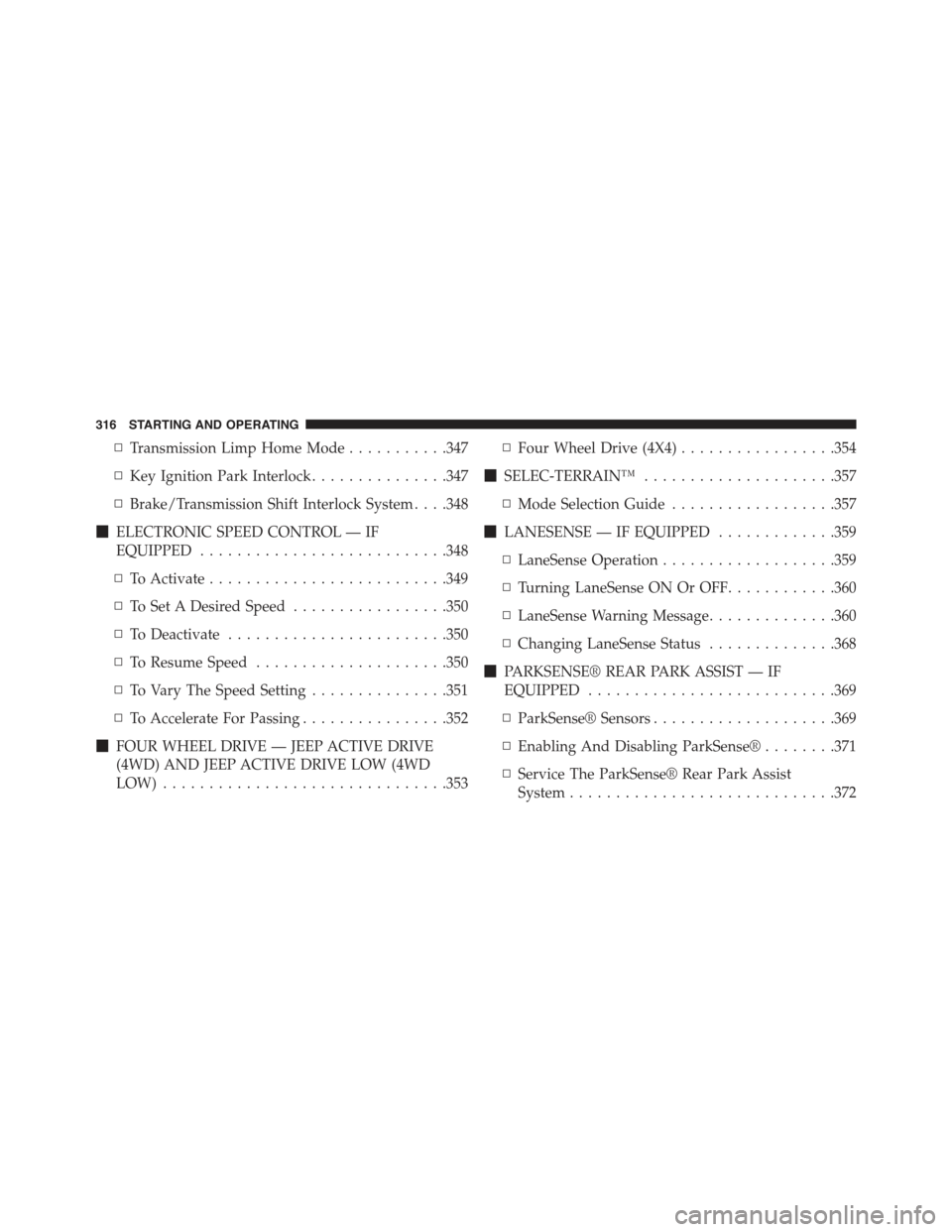
▫Transmission Limp Home Mode...........347
▫Key Ignition Park Interlock...............347
▫Brake/Transmission Shift Interlock System . . . .348
!ELECTRONIC SPEED CONTROL — IF
EQUIPPED...........................348
▫To Activate..........................349
▫To Set A Desired Speed.................350
▫To Deactivate........................350
▫To Resume Speed.....................350
▫To Vary The Speed Setting...............351
▫To Accelerate For Passing................352
!FOUR WHEEL DRIVE — JEEP ACTIVE DRIVE
(4WD) AND JEEP ACTIVE DRIVE LOW (4WD
LOW)...............................353
▫Four Wheel Drive (4X4).................354
!SELEC-TERRAIN™.....................357
▫Mode Selection Guide..................357
!LANESENSE — IF EQUIPPED.............359
▫LaneSense Operation...................359
▫Turning LaneSense ON Or OFF............360
▫LaneSense Warning Message..............360
▫Changing LaneSense Status..............368
!PARKSENSE® REAR PARK ASSIST — IF
EQUIPPED...........................369
▫ParkSense® Sensors....................369
▫Enabling And Disabling ParkSense®........371
▫Service The ParkSense® Rear Park Assist
System.............................372
316 STARTING AND OPERATING
Page 371 of 678

PARKSENSE® REAR PARK ASSIST — IF
EQUIPPED
The ParkSense® Rear Park Assist system provides visual
and audible indications of the distance between the rear
fascia and a detected obstacle when backing up, e.g.
during a parking maneuver. Refer to ParkSense® System
Usage Precautions for limitations of this system and
recommendations.
ParkSense® will retain the last system state (enabled or
disabled) from the last ignition cycle when the ignition is
changed to the MAR/RUN position.
ParkSense® can be active only when the shift lever/gear
selector is in REVERSE. If ParkSense® is enabled at this
shift lever position, the system will remain active until
the vehicle speed is increased to approximately 7 mph
(11 km/h) or above. When in REVERSE and above the
system’s operating speed, a warning will appear within
the Electronic Vehicle Information Center (EVIC) or
Driver Information Display (DID).
ParkSense® Sensors
The four ParkSense® sensors, located in the rear fascia/
bumper, monitor the area behind the vehicle that is
within the sensors’ field of view. The sensors can detect
obstacles from approximately 12 in (30 cm) up to 59 in
(150 cm) from the rear fascia/bumper in the horizontal
direction, depending on the location, type and orienta-
tion of the obstacle.7
STARTING AND OPERATING 369
Page 372 of 678
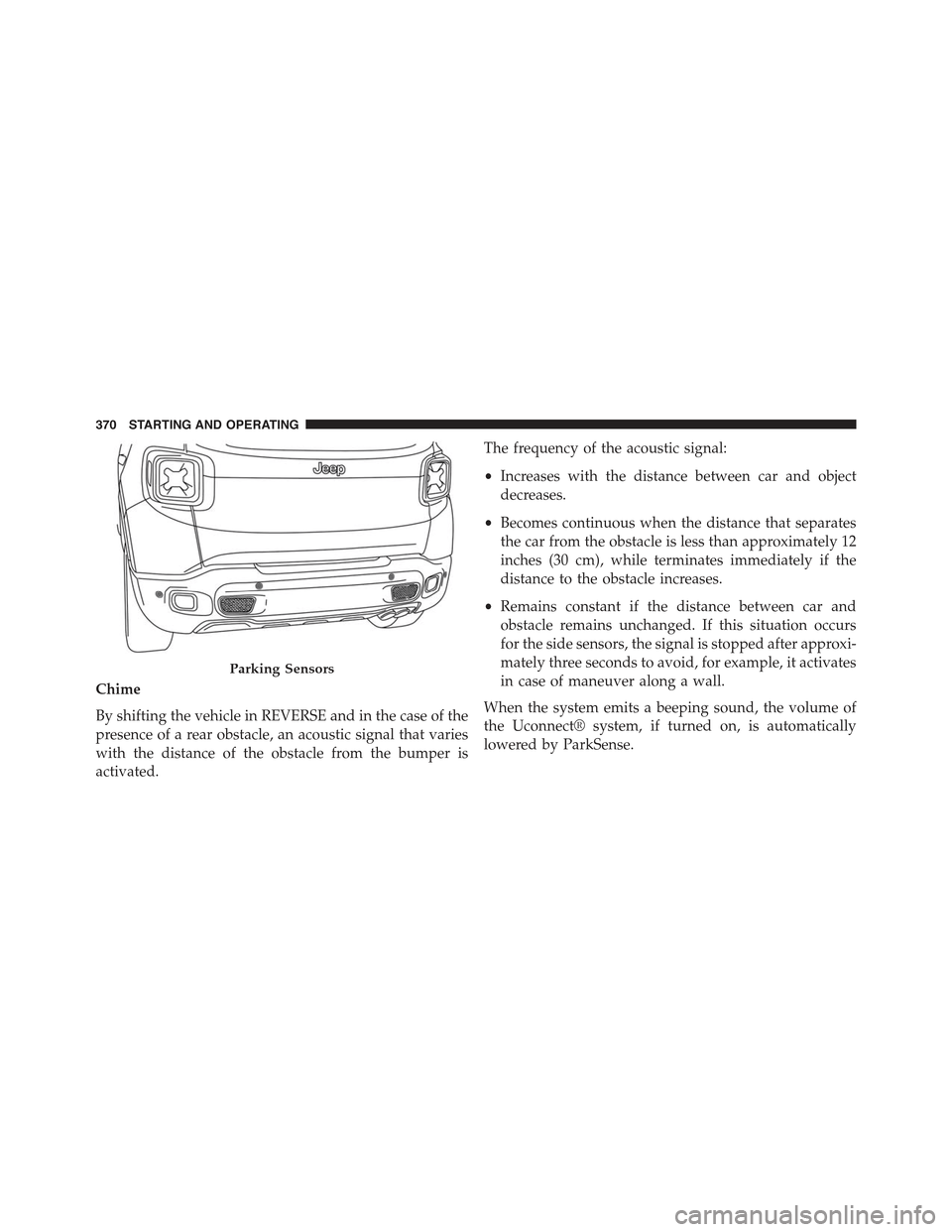
Chime
By shifting the vehicle in REVERSE and in the case of the
presence of a rear obstacle, an acoustic signal that varies
with the distance of the obstacle from the bumper is
activated.
The frequency of the acoustic signal:
•Increases with the distance between car and object
decreases.
•Becomes continuous when the distance that separates
the car from the obstacle is less than approximately 12
inches (30 cm), while terminates immediately if the
distance to the obstacle increases.
•Remains constant if the distance between car and
obstacle remains unchanged. If this situation occurs
for the side sensors, the signal is stopped after approxi-
mately three seconds to avoid, for example, it activates
in case of maneuver along a wall.
When the system emits a beeping sound, the volume of
the Uconnect® system, if turned on, is automatically
lowered by ParkSense.
Parking Sensors
370 STARTING AND OPERATING
Page 373 of 678

Detection Distances
If the sensors detect more obstacles, it is taken into
account only what is the shorter distance.
Instrument Cluster Display
ParkSense is displayed on the instrument cluster only if
you have selected the item#beep and display#inside the
#Settings#menu of the Uconnect® system.
If an obstacle is detected in the center rear region, the
display will show a single solid arc in the center rear
region and will produce a one-half second tone. As the
vehicle moves closer to the obstacle, the display will
show the single arc moving closer to the vehicle and the
sound tone will change from slow, to fast, to continuous.
If an obstacle is detected in the left and/or right rear
region, the display will show a single flashing arc in the
left and/or right rear region and will produce a fast
sound tone. As the vehicle moves closer to the obstacle,
the display will show the single arc moving closer to the
vehicle and the tone will change from fast to continuous.
In general, the car is closest to the obstacle when the
display shows only a flashing arc and the chime becomes
continuous.
The color on the display depends on the distance and
location of the obstacle.
Enabling And Disabling ParkSense®
ParkSense® can be enabled and disabled with the
ParkSense® switch.
When the ParkSense® switch is pressed to
disable the system, the instrument cluster will
display the “PARKSENSE OFF” message for
approximately five seconds. Refer to “Elec-
tronic Vehicle Information Center (EVIC)” or “Driver
Information Display (DID)” in “Getting To Know Your
Instrument Panel” for further information. When the
7
STARTING AND OPERATING 371
Page 374 of 678
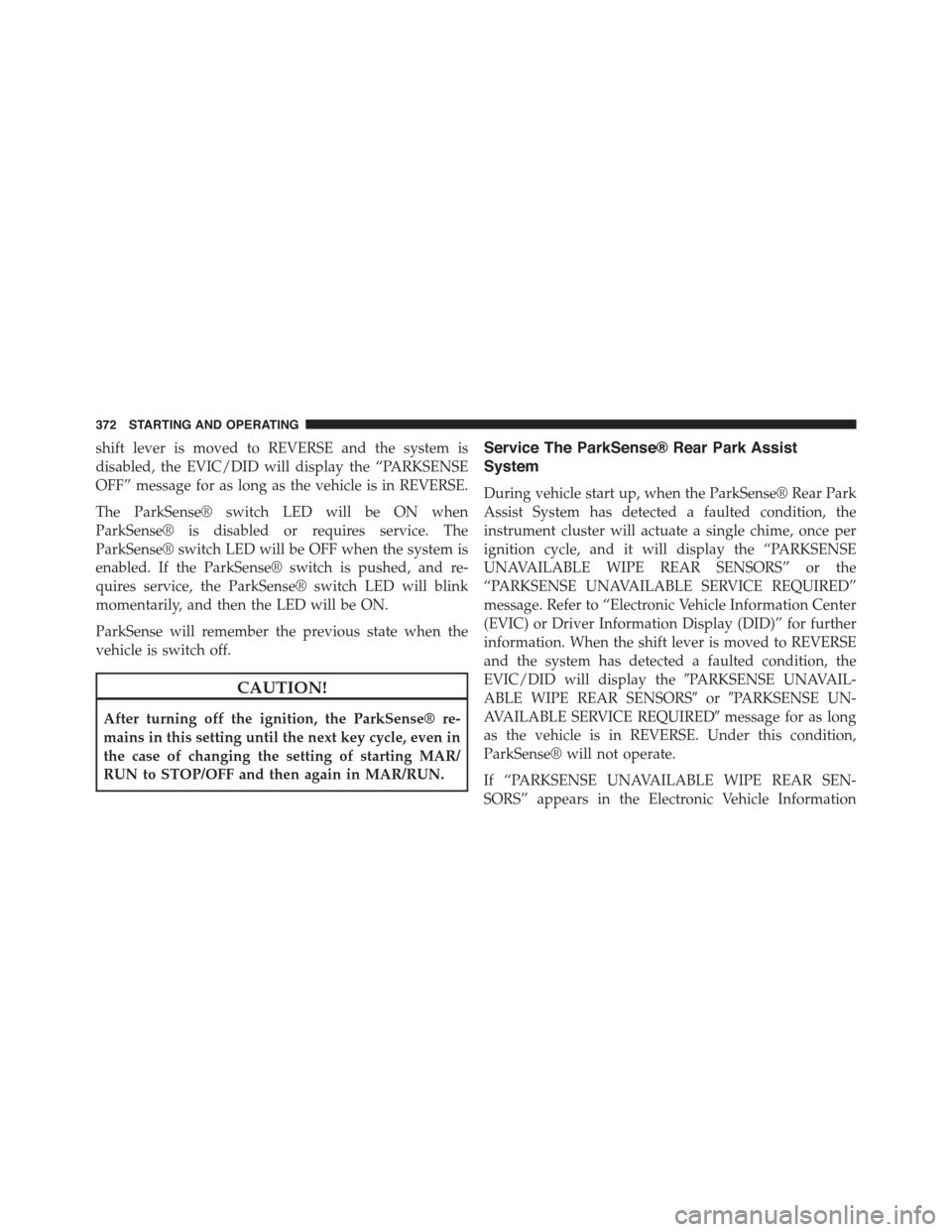
shift lever is moved to REVERSE and the system is
disabled, the EVIC/DID will display the “PARKSENSE
OFF” message for as long as the vehicle is in REVERSE.
The ParkSense® switch LED will be ON when
ParkSense® is disabled or requires service. The
ParkSense® switch LED will be OFF when the system is
enabled. If the ParkSense® switch is pushed, and re-
quires service, the ParkSense® switch LED will blink
momentarily, and then the LED will be ON.
ParkSense will remember the previous state when the
vehicle is switch off.
CAUTION!
After turning off the ignition, the ParkSense® re-
mains in this setting until the next key cycle, even in
the case of changing the setting of starting MAR/
RUN to STOP/OFF and then again in MAR/RUN.
Service The ParkSense® Rear Park Assist
System
During vehicle start up, when the ParkSense® Rear Park
Assist System has detected a faulted condition, the
instrument cluster will actuate a single chime, once per
ignition cycle, and it will display the “PARKSENSE
UNAVAILABLE WIPE REAR SENSORS” or the
“PARKSENSE UNAVAILABLE SERVICE REQUIRED”
message. Refer to “Electronic Vehicle Information Center
(EVIC) or Driver Information Display (DID)” for further
information. When the shift lever is moved to REVERSE
and the system has detected a faulted condition, the
EVIC/DID will display the#PARKSENSE UNAVAIL-
ABLE WIPE REAR SENSORS#or#PARKSENSE UN-
AVAILABLE SERVICE REQUIRED#message for as long
as the vehicle is in REVERSE. Under this condition,
ParkSense® will not operate.
If “PARKSENSE UNAVAILABLE WIPE REAR SEN-
SORS” appears in the Electronic Vehicle Information
372 STARTING AND OPERATING